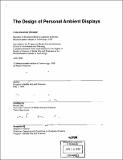| dc.contributor.advisor | Hiroshi Ishii. | en_US |
| dc.contributor.author | Wisneski, Craig Alexander, 1975- | en_US |
| dc.contributor.other | Massachusetts Institute of Technology. Dept. of Architecture. Program in Media Arts and Sciences. | en_US |
| dc.date.accessioned | 2005-11-08T19:43:21Z | |
| dc.date.available | 2005-11-08T19:43:21Z | |
| dc.date.copyright | 1999 | en_US |
| dc.date.issued | 1999 | en_US |
| dc.identifier.uri | http://hdl.handle.net/1721.1/29541 | |
| dc.description | Thesis (S.M.)--Massachusetts Institute of Technology, Program in Media Arts & Sciences, 1999. | en_US |
| dc.description | Includes bibliographical references (leaves 58-59). | en_US |
| dc.description.abstract | The goal of this thesis is to investigate the design of personal ambient displays. These are small, physical devices worn to display information to a person in a subtle, persistent, and private manner. They can be small enough to be carried in a pocket, worn as a watch, or even adorned like jewelry. In my implementations, information is displayed solely through tactile modalities such as thermal change (heating and cooling), movement (shifting and vibration), and change of shape (expanding, contracting, and deformation). Using a tactile display allows information to be kept private and reduces the chance of overloading primary visual and auditory activities. The display can remain ambient, transmitting information in the background of a person's perception through simple, physical means. The specific focus of this thesis is to create a number of these tactile displays, to identify and implement applications they can serve, and to evaluate aspects of their effectiveness. I have created a group of small, wireless objects that can warm up and cool down or gently move or shift. Users can reconfigure each display so that information sources like stock data or the activity of people on the internet are mapped to these different tactile modalities. Furthermore, in this thesis I consider the implications that human perception have on the design of these displays and examine potential application areas for further implementations. | en_US |
| dc.description.statementofresponsibility | Craig Alexander Wisneski. | en_US |
| dc.format.extent | 59 leaves | en_US |
| dc.format.extent | 3828055 bytes | |
| dc.format.extent | 3827861 bytes | |
| dc.format.mimetype | application/pdf | |
| dc.format.mimetype | application/pdf | |
| dc.language.iso | eng | en_US |
| dc.publisher | Massachusetts Institute of Technology | en_US |
| dc.rights | M.I.T. theses are protected by copyright. They may be viewed from this source for any purpose, but reproduction or distribution in any format is prohibited without written permission. See provided URL for inquiries about permission. | en_US |
| dc.rights.uri | http://dspace.mit.edu/handle/1721.1/7582 | |
| dc.subject | Architecture. Program in Media Arts and Sciences. | en_US |
| dc.title | The design of personal ambient displays | en_US |
| dc.type | Thesis | en_US |
| dc.description.degree | S.M. | en_US |
| dc.contributor.department | Program in Media Arts and Sciences (Massachusetts Institute of Technology) | |
| dc.identifier.oclc | 43932228 | en_US |
